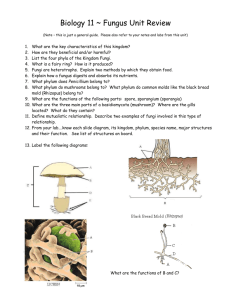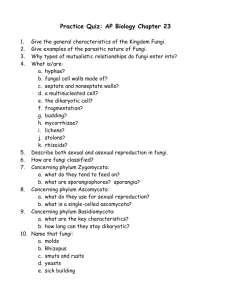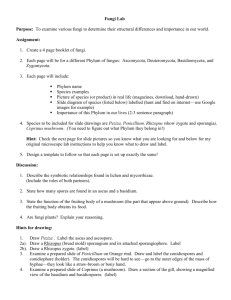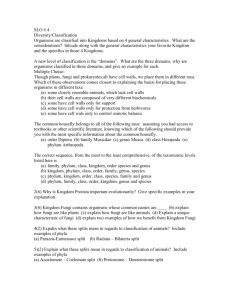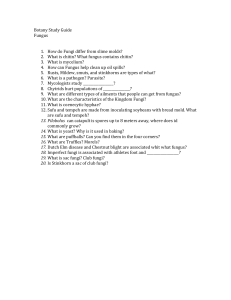Kingdom Protista Phylum Ciliophora
advertisement
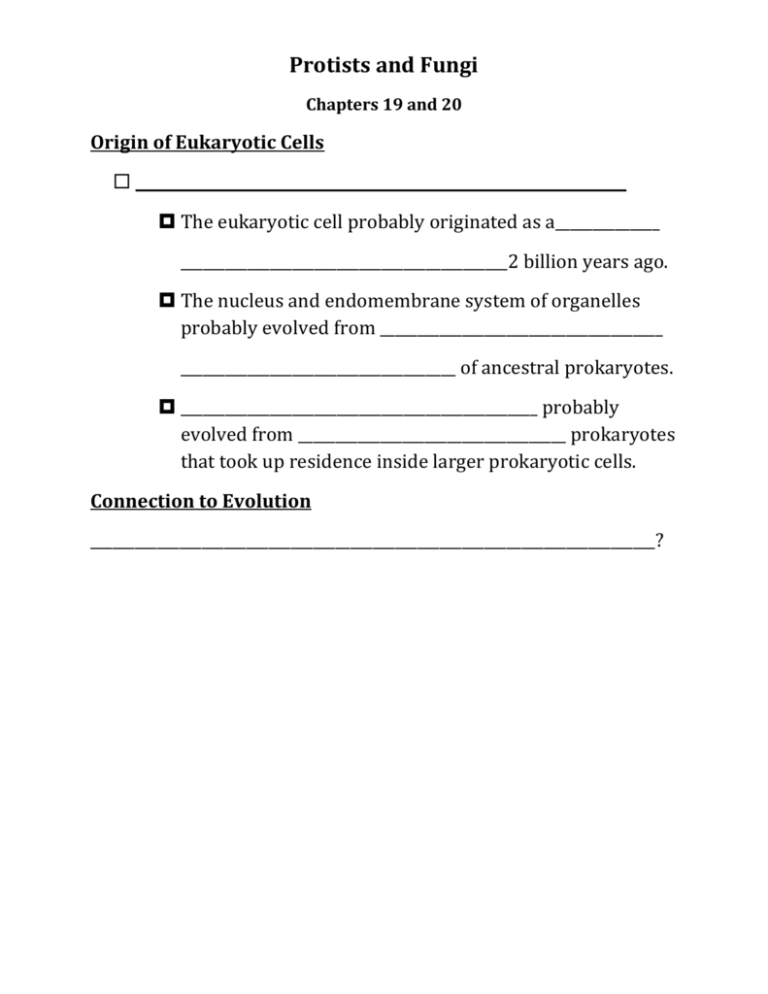
Protists and Fungi Chapters 19 and 20 Origin of Eukaryotic Cells __________________________________________________________________ The eukaryotic cell probably originated as a______________ ____________________________________________2 billion years ago. The nucleus and endomembrane system of organelles probably evolved from ______________________________________ _____________________________________ of ancestral prokaryotes. ________________________________________________ probably evolved from ____________________________________ prokaryotes that took up residence inside larger prokaryotic cells. Connection to Evolution ____________________________________________________________________________? DOMAIN EUKARYA KINGDOM PROTISTA Characteristics of a Protist: Often characterized by what they are _______________________ Not animals, plants, or fungi Diverse group of 200,000 organisms Cell type: _____________________________________________________ Mode of Nutrition: ___________________________________________ Habitat: ___________________________________________; some live in animals causing disease Categorizing Protists 1) Animal-like (______________________________________________) 2) Plantlike (___________________________________________________) 3) Fungus-like (__________________________________________________) Protozoa ________________________________________________________________________ Four Phlya: Phylum Ciliophora: _________________________________________ Phylum Sarcodina: _________________________________________ Phylum Apicomplexa: _____________________________________ Phylum Zoomastigina: _____________________________________ Kingdom Protista Phylum Ciliophora AKA: ________________________________________________________________ Use short, hair-like projections to move through fluids and move food particles into the cell 7000 species of ciliates Abundant in ___________________________________________________ Example: ____________________________________________________ Kingdom Protista Phylum Sarcodina Animal-like protists that ___________________________________________ Pseudopod: ___________________________________; a temporary extension of ___________________________________ that surrounds and envelops smaller organisms, forming a food vacuole Example: _____________________________________ Kingdom Protista Phylum Apicomplexa AKA: ________________________________________________________________ Produce spores (reproductive cells) during their life cycle _________________________________________________________________ Hosts transmit the spores to new hosts Example: ___________________________________________________________ Kingdom Protista Phylum Zoomastigina AKA: _________________________________________________________________ Use ___________________________________________ to move Cause ________________________________________________________________ Example: __________________________________________________________ Infects a tsetse fly which transmits disease to humans Algae Plant-like protists because they contain __________________________ _____________________________________________________________ Found in bodies of water Can be ________________________________________________________________ Unicellular Phyla: Phylum Bacillariophyta: _____________________________________ Phylum Pyrrophyta: _____________________________________ Phylum Euglenophyta: _____________________________________ Phylum Chrysophyta: _____________________________________ Multicellular Phyla: Phylum Phaeophyta: _____________________________________ Phylum Chlorophyta: _____________________________________ Phylum Rhodophyta: _____________________________________ Kingdom Protista Plant-like Examples Diatoms _____________________________________ Photosynthetic autotrophs using chlorophyll (green pigment) and carotenoids (golden pigment) Store food as oil, which is less dense that water __________________________________________________________________ __________________________________________________________________ Dinoflagellates _____________________________________ Have _____________________________________at right angles to one another Cause the organism to spin as they move through the water Some are photosynthetic autotrophs and others are heterotrophs Some use _____________________________________ for photosynthesis, which cause __________________________ during blooms Produce dangerous toxins Green Algae _____________________________________ Use chlorophyll for photosynthesis Have cell walls and store food as carbohydrates Most are found in freshwater Kingdom Protista Fungus-Like Examples AKA: _____________________________________ Similar to fungus: Use _____________________________________ to reproduce Feed on _____________________________________ and absorb nutrients through their cell walls Different from fungus: Fungi cell walls contain chitin, a complex carbohydrate. Slime mold cell walls _____________________________________. Connection to Evolution Protists are mainly unicellular. __________________________________________ ______________________________________________________________________________ Evolution of Multicellular Organisms Multicellular organisms probably evolved from colonial protist cells becoming _____________________________________ Multicellular life has diversified over hundreds of millions of years Multicellular life first arose over a billion years ago All life was aquatic until almost 500 million years ago DOMAIN EUKARYA KINGDOM FUNGI Characteristics of Fungi _____________________________________ - over 100,000 species have been identified Some are mutualistic organisms Others are _____________________________________ Some are _____________________________________ Others are _____________________________________ Type of cell: _____________________________________ Mode of nutrition: _____________________________________ Number of cells: Most are _____________________________________ _____________________________________are unicellular Cell structure: cell wall composed of ______________________________ Unique Fungi Characteristics _____________________________________: long chains of cells; threadlike filaments that make up the body of the fungus _____________________________________: netlike mass of hyphae; sometimes underground _____________________________________: fungus seen above ground; example-mushroom Nutrition in Fungus All fungi are _____________________________________, but there are three types of fungi that differ in how they obtain nutrients. _____________________________________: DECOMPOSER Feed on dead organisms or organic wastes Return nutrients to the food chain _____________________________________: absorb nutrients from the living cells of a host organism _____________________________________: WORK TOGETHER Example: Soybean root fungus receives sugar from the soybean root and helps the root to increase water and mineral uptake. Phyla of Fungi 1. _____________________________________are closely related to protists. They are _____________________________________. Earliest fungi. 2. _____________________________________are multicellular and composed of _____________________________________on the surface and _____________________________________that penetrate the surface. 3. _____________________________________are the most commonly recognized fungus. They are multicellular. 4. Yeast is unicellular, but most members are multicellular. Ecology of Fungi _____________________________________consist of fungi living _____________________________________with photosynthetic organisms. Lichens are associations of algae or cyanobacteria with a network of fungal hyphae. The fungus receives food in exchange for housing, water, and minerals. Lichen serves as _____________________________________ or environmental changes. Parasitic Fungi Parasitic fungi cause disease Dutch elm disease Corn smut Athlete’s foot Beneficial Fungi Numerous fungi are beneficial Many are important in the decomposition of organic material and _____________________________________ Fungi are also important as food _____________________________________are the fruiting bodies of subterranean fungi _____________________________________ (unicellular fungi) are essential for baking and beer and wine production Fungi are used to ripen _____________________________________ _____________________________________– First antibiotic to be discovered
